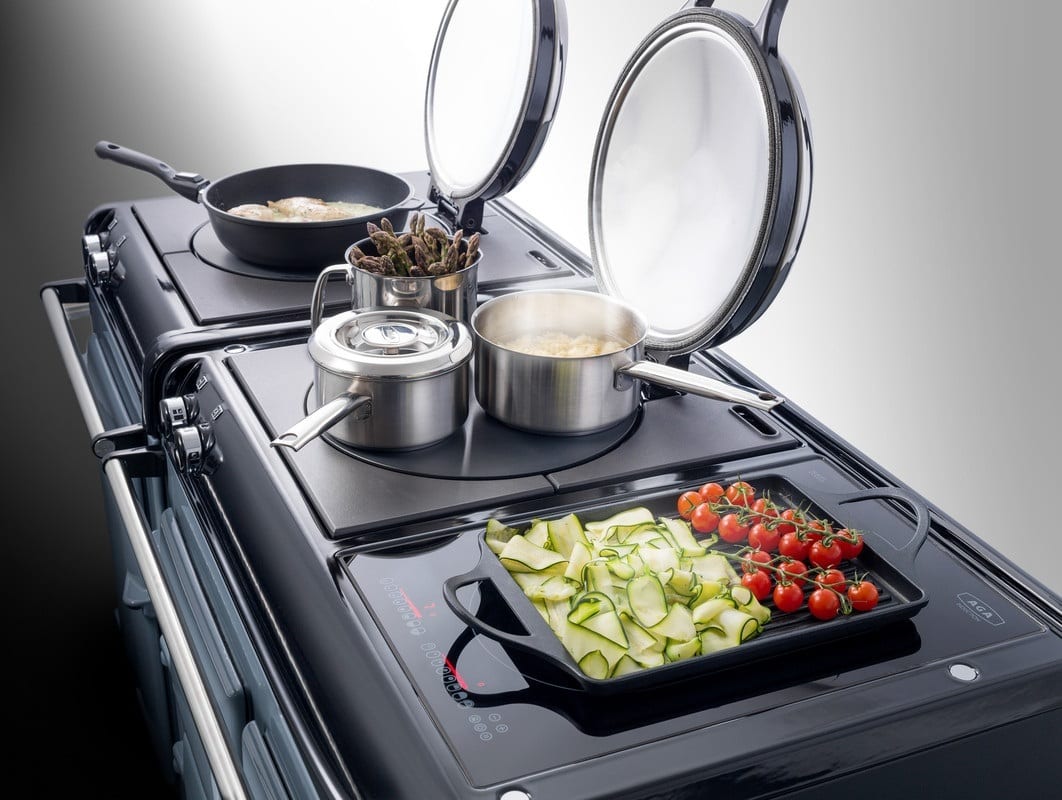What is the difference between induction and ceramic?
In the most part ceramic and induction hobs can look almost exactly the same. So why are induction hobs so much more expensive? In this guide we explain the difference between ceramic and induction to help you decide which one’s for you.

The main difference between ceramic and induction cooktops is how they create heat. Ceramic hobs contain coiled metal elements under the tempered ceramic glass which electronically heat to the desired temperature. In other words, the coils heat the ceramic surface to warm up your saucepan. The elements do cycle on and off during use making accurate heat control less than induction cooktops. Induction hobs feature powerful, high-frequency electromagnets which generate a magnetic field that heats the pan and not the hob’s surface.
In short, induction cooktops are far more efficient than ceramic cooktops as they only heat the pan and not the surrounding air or the hob’s surface. Induction cooktops remain cooler during the cooking process, the ceramic top only heats from residual pan heat and loses heat quicker once turned off.
Control
Both ceramic and induction cooktops can help you prepare food with accuracy and control. However, there are still some differences between them that buyers should be aware of. Induction and ceramic cooktops tend to feature digital, touch controls. As well as adding to the design value of the cooktop, this also helps you to be more precise when setting heat levels. Other valuable features of touch controls such as child or control panel locks, timers, pause buttons and so on can be very useful for the busy householder. Induction cooktops, however, offer more cooking control than ceramic cooktops as they can respond to a change in heat settings in an instant. Electric cooktops need time to heat up, something that you may struggle with for some recipes.
Safety
Both ceramic and induction cooktops offer a wide range of effective safety features that significantly reduce the risk of injury and damage to the cooktop. Induction cooktops are ideal for any home with small children as the surface doesn’t get as hot as a ceramic top and only activates even when switched on until a pan is placed on the zone. Ceramic cooktops, however, do retain considerable heat after cooking up to four or five times higher than induction, however, most models now come with a residual heat indicator so you always know which zones are still too hot to touch or clean. Certain models offer added safety features that will turn the heat off if there is a spillage or if the pan that has been placed on the cooking zone is empty. The latter of these features can prevent lasting damage and costly repairs.
Speed
Ceramic cooktops cannot compete with induction when it comes to the speed with which they heat. Ceramic is slower than induction because the element takes time to heat up and also, because heat is lost during the transfer between the ceramic hobs and the cookware. The magnetic field created by an induction hob heats the pan instantly. Given no heat is lost into the cooktop surface or the surrounding air, cooking times are greatly reduced.
Cleaning
Most induction and ceramic cooktops feature digital touch controls meaning they are totally flat. This is great news when it comes to cleaning the hob. Most ceramic and induction hobs are flat, smooth surfaces which means there are no crevices for food to fall into. This in turn means that cleaning the hob is usually just a case of wiping it down. However, because ceramic hobs heat up, spilled food can bake onto the surface. It's important to wipe spills from a ceramic hob when safe to do so. Leaving cooked or burnt food on the hob will only make cleaning and maintenance harder.
Cookware
Induction cooktops require a specific kind of cookware; ceramic cooktops will accept almost all types of cookware but are less energy efficient. Be aware that opting for an induction hob may mean that you have to replace some of your existing cookware. A quick check is to place a magnet on the base of your cookware, If the magnet sticks firmly you should be fine, cast iron is great and a large griddle pan is a great addition to your induction top for a bigger cooking area and a good flat base wok will make Asian cookery a pleasure. Ceramic hobs perform better when used with flat-bottomed cookware as it increases the amount of the pan that is in contact with the heat and so reduces warm up times. If you opt for an induction cooktop check with your cooking specialist to assist with sizes and styles of cookware that best suit your cooking preferences as cookware has also advanced with time.
Cost
The cost of purchasing and running ceramic and induction cooktops differs greatly. It is important to consider your style of cooking, safety, energy bills and your time when deciding which is the most appropriate. An induction cooktop may be a slightly higher initial cost but a far better option long term. Ceramic tend to be less expensive to purchase than induction cooktops. Where electric elements are reasonably consistent in quality induction coils can vary greatly in quality and performance. As the tempered glass top is quite consistent in quality the induction coils are what will make a considerable difference when in use. Check with your cooking specialist to discuss power levels, zone layout, other features, warranty etc to determine the best cooktop for your circumstances
Contact
If you would like to learn more about the difference, please get into touch with us today by calling 0118 393046 or email info@edwardsandgodding.co.uk



